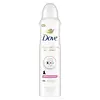What's inside
What's inside
 Key Ingredients
Key Ingredients

 Benefits
Benefits

 Concerns
Concerns

 Ingredients Side-by-side
Ingredients Side-by-side

Aluminum Sesquichlorohydrate 12.2%
AstringentButane
Hydrofluorocarbon 152a
Cyclopentasiloxane
EmollientIsobutane
PPG-14 Butyl Ether
Skin ConditioningGlycine
BufferingParfum
MaskingHelianthus Annuus Seed Oil
EmollientC12-15 Alkyl Benzoate
AntimicrobialDisteardimonium Hectorite
StabilisingCalcium Chloride
AstringentPropane
BHT
AntioxidantOctyldodecanol
EmollientPropylene Carbonate
SolventDimethiconol
EmollientAlpha-Isomethyl Ionone
PerfumingBenzyl Alcohol
PerfumingBenzyl Salicylate
PerfumingCitral
PerfumingCitronellol
PerfumingHexyl Cinnamal
PerfumingIsoeugenol
PerfumingLimonene
PerfumingLinalool
PerfumingAluminum Sesquichlorohydrate 12.2%, Butane, Hydrofluorocarbon 152a, Cyclopentasiloxane, Isobutane, PPG-14 Butyl Ether, Glycine, Parfum, Helianthus Annuus Seed Oil, C12-15 Alkyl Benzoate, Disteardimonium Hectorite, Calcium Chloride, Propane, BHT, Octyldodecanol, Propylene Carbonate, Dimethiconol, Alpha-Isomethyl Ionone, Benzyl Alcohol, Benzyl Salicylate, Citral, Citronellol, Hexyl Cinnamal, Isoeugenol, Limonene, Linalool
Butane
Isobutane
Propane
Isopropyl Palmitate
EmollientAluminum Chlorohydrate
AstringentDicaprylyl Ether
EmollientCaprylic/Capric Triglyceride
MaskingOctyldodecanol
EmollientTriethyl Citrate
MaskingParfum
MaskingPalmitamidopropyltrimonium Chloride
Propylene Glycol
HumectantDisteardimonium Hectorite
StabilisingPropylene Carbonate
SolventTocopherol
AntioxidantAlpha-Isomethyl Ionone
PerfumingBenzyl Alcohol
PerfumingButane, Isobutane, Propane, Isopropyl Palmitate, Aluminum Chlorohydrate, Dicaprylyl Ether, Caprylic/Capric Triglyceride, Octyldodecanol, Triethyl Citrate, Parfum, Palmitamidopropyltrimonium Chloride, Propylene Glycol, Disteardimonium Hectorite, Propylene Carbonate, Tocopherol, Alpha-Isomethyl Ionone, Benzyl Alcohol
Ingredients Explained
These ingredients are found in both products.
Ingredients higher up in an ingredient list are typically present in a larger amount.
Alpha-Isomethyl Ionone is a fragrance. It can be synthetically created or naturally occurring.
The scent of Alpha-Isomethyl Ionone is described as "flowery" but can also be "woody".
Naturally occurring Alpha-Isomethyl Ionone may be found in Saccharomyces cerevisiae, or the yeast used to make wine and bread.
The term 'fragrance' is not regulated in many countries. In many cases, it is up to the brand to define this term. For instance, many brands choose to label themselves as "fragrance-free" because they are not using synthetic fragrances. However, their products may still contain ingredients such as essential oils that are considered a fragrance.
Learn more about Alpha-Isomethyl IononeBenzyl Alcohol is most commonly used as a preservative. It also has a subtle, sweet smell. Small amounts of Benzyl Alcohol is not irritating and safe to use in skincare products. Most Benzyl Alcohol is derived from fruits such as apricots.
Benzyl Alcohol has both antibacterial and antioxidant properties. These properties help lengthen the shelf life of products. Benzyl Alcohol is a solvent and helps dissolve other ingredients. It can also improve the texture and spreadability.
Alcohol comes in many different forms. Different types of alcohol will have different effects on skin. This ingredient is an astringent alcohol.
Using high concentrations of these alcohols are drying on the skin. They may strip away your skin's natural oils and even damage your skin barrier. Astringent alcohols may also irritate skin.
Other types of astringent alcohols include:
According to the National Rosacea Society based in the US, you should be mindful of products with these alcohols in the top half of ingredients.
Any type of sanitizing product will have high amounts of alcohol to help kill bacteria and viruses.
Learn more about Benzyl AlcoholButane is a gas derived from petroleum and natural gas. It is used as an aerosol propellant.
Disteardimonium Hectorite comes from the clay mineral named hectorite. It is used to add thickness to a product.
It can also help stabilize a product by helping to disperse other ingredients.
Hectorite is a rare, white clay mineral.
Learn more about Disteardimonium HectoriteWe don't have a description for Isobutane yet.
Octyldodecanol is a fatty alcohol. It is primarily used to enhance the texture of products.
As an emulsifier, Octyldodecanol helps prevent the oils and waters from separating. It also prevents ingredients from creating foam when shaken.
Octyldodecanol is created by reducing fatty acid to an alcohol.
Due to its high molecular weight, it does not get absorbed into the skin.
Learn more about OctyldodecanolParfum is a catch-all term for an ingredient or more that is used to give a scent to products.
Also called "fragrance", this ingredient can be a blend of hundreds of chemicals or plant oils. This means every product with "fragrance" or "parfum" in the ingredients list is a different mixture.
For instance, Habanolide is a proprietary trade name for a specific aroma chemical. When used as a fragrance ingredient in cosmetics, most aroma chemicals fall under the broad labeling category of “FRAGRANCE” or “PARFUM” according to EU and US regulations.
The term 'parfum' or 'fragrance' is not regulated in many countries. In many cases, it is up to the brand to define this term.
For instance, many brands choose to label themselves as "fragrance-free" because they are not using synthetic fragrances. However, their products may still contain ingredients such as essential oils that are considered a fragrance by INCI standards.
One example is Calendula flower extract. Calendula is an essential oil that still imparts a scent or 'fragrance'.
Depending on the blend, the ingredients in the mixture can cause allergies and sensitivities on the skin. Some ingredients that are known EU allergens include linalool and citronellol.
Parfum can also be used to mask or cover an unpleasant scent.
The bottom line is: not all fragrances/parfum/ingredients are created equally. If you are worried about fragrances, we recommend taking a closer look at an ingredient. And of course, we always recommend speaking with a professional.
Learn more about ParfumPropane is a gas derived from petroleum and natural gas. It is used as a propellant.
This ingredient is most commonly used in shaving cream, hair products, and makeup.
This ingredient is a solvent. It helps dissolve active ingredients and alter the texture of products.
Propylene Carbonate is commonly used in makeup and with clay, such as montmorillonite or bentonite.
Studies show this ingredient to be safe for cosmetics. When it is undiluted, it can cause skin irritation. (It is always diluted in skincare and makeup). This ingredient is water-soluble.
Propylene Carbonate is created from propylene glycol and carbonic acid.
Learn more about Propylene Carbonate